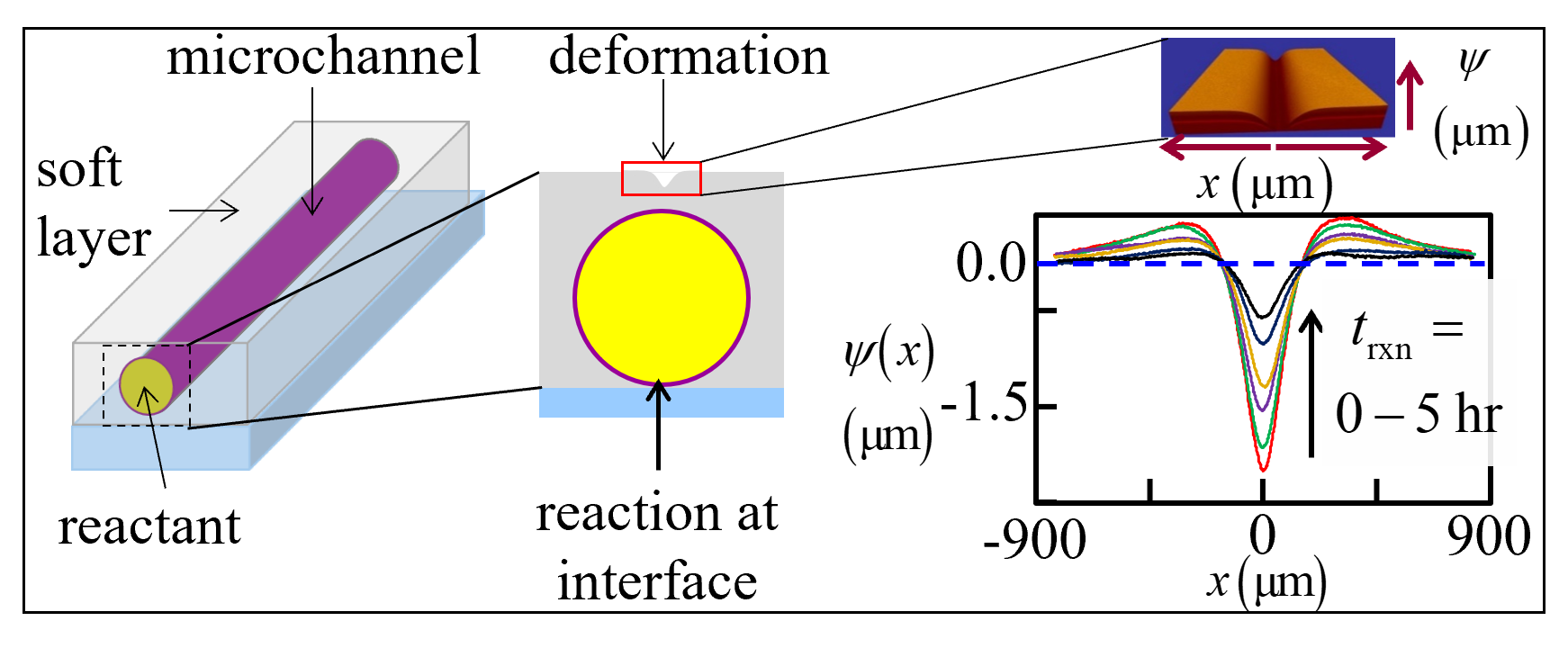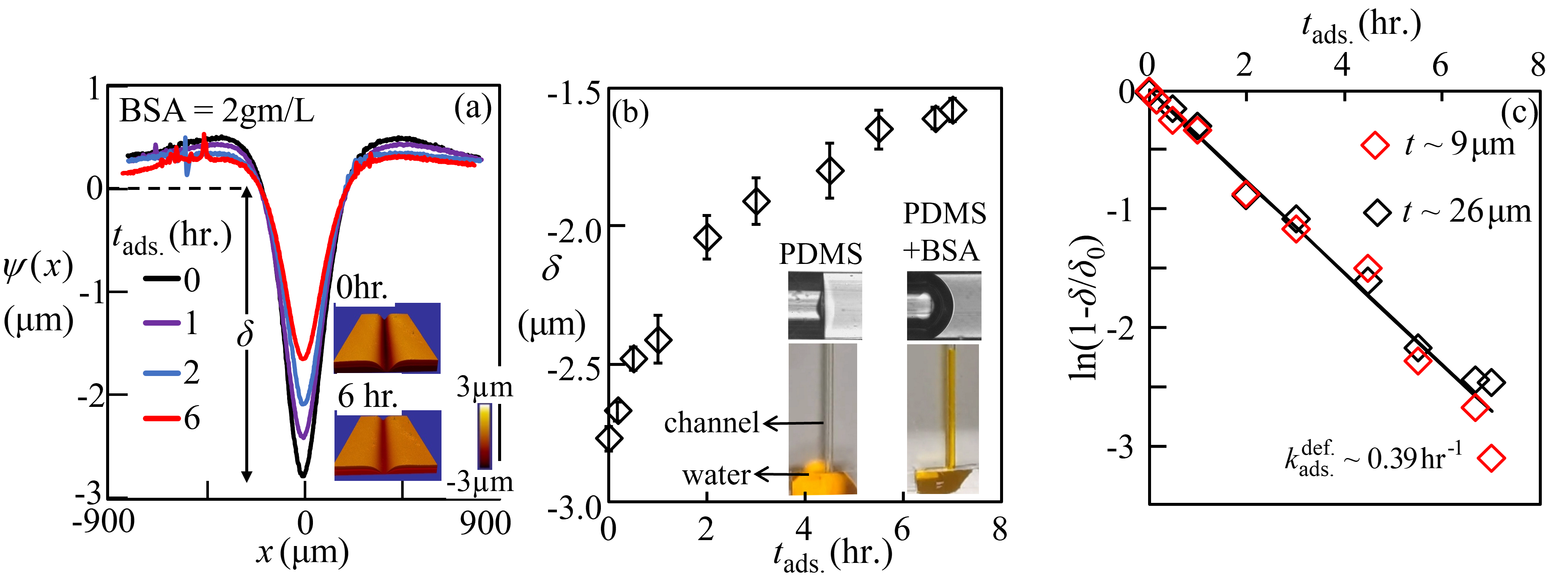Monitoring of rate of a surface reaction using elastocapillary effect
Curved surface of a soft solid undergoes deformation when its surface tension gets altered. This phenomenon is known as elastocapillary effect, which is encountered in many situations: smoothing of undulations on the surface of a soft solid, blunting of sharp corner, Plateau-Rayleigh instability in a soft cylindrical solid, stiffening of a solid embedded with liquid drops and so on. The extent of such deformations can be expressed in terms of elastocapillary length. While for many moderately soft solids the elasto-capillary length and therefore the deformation is too small to be measurable via optical methods, there are others in which geometric amplification can lead to significant deformation. We have explored this effect in two different contexts: deformation of a soft solid driven by surface tension of a sessile liquid drop and deformation of fluidic vessels embedded inside a thin elastic film. In this talk I will go through these results and will show how the elasto-capillary effect can be used in monitoring and enhancing the rate of a reaction occurring at the interface of a soft solid and a liquid.
References
- Singh, N., Ghatak, A. Enhancement of the rate of surface reactions by elasto-capillary effect. Langmuir, 2024, Vol 40(17), pp 8771Ė8780.
- Singh, N., Kumar, A., Ghatak, A. Studying Kinetics of a Surface Reaction using Elastocapillary Effect. Journal of Colloids and Interfacial Sciences, 2023, Vol 645, pp 266-275.


Bio-Inspired Design of Hierarchically Structured Adhesive
The mechanism by which many creatures like house lizards and geckos can run at ease on a vertical wall and yet remain strongly adhered has been linked to hierarchically patterned micro-structures: flexible pads, hairs and subsurface fluidic vessels at their feet. How these features of different length-scales and the associated physical phenomena couple to engender this ‚Äúsmart‚ÄĚ adhesive, is a subject of active interest. In this context, we have designed elastomeric films of poly(dimethylsiloxane) embedded with stack of planer microchannels, curved and straight channels. During indentation experiments, deformation and self-adhesion of these structures enhance the effective area of adhesion with consequent increase in adhesion hysteresis over orders of magnitude. In addition, suitable orientation of these buried channels allows generation of load dependent hysteresis and its spatial modulation. In a separate set of experiments, the internal surfaces of the channels have been textured with microscopic pillars arranged in regular arrays.These textures on the channel surface enhance adhesion via crack arrest and initiation
mechanism.Furthermore, the adhesive is treated by hydrochloric acid so that the siloxane bonds present on the exposed surfaces are hydrolyzed generating silanol groups which on two contacting surfaces increase the effect of self-adhesion hysteresis.Thus, the combined effect of surface texturing is integrated with the chemical treatment to increase adhesion.
References
- Arul Ed. P. and Ghatak, A. Bio-inspired design of a hierarchically structured adhesive.Langmuir, 2009, Vol. 25(1), pp. 611-617.
- Arul, Ed. P. and Ghatak, A., Adhesives with patterned sub-surface micro-structures. Journal of Material Science, 2011, Vol 46(3), pp. 832-838.


Control of Adhesionvia Internally Pressurized Subsurface Micro-channels
While pressure sensitive adhesives in general consists of a layer of viscoelastic glue sandwiched between two adherents, we have introduced the design of an adhesive embedded with micro-channels which remain either open to atmosphere or pressurized to different positive and negative pressures. We have subjected these layers to indentation by a rigid cylindersuch that in addition to adhesion between the indenter and the adhesive surface, the inner walls of the channelstooself-adhere; during retraction of the indenter, these surfaces debond, but at a different load, thus resulting in hysteresis. When these channels are pressurized to different extents, the contact areas of various interfaces vary, so also the resultant hysteresis.For experiments with constant depth of indentation, the hysteresis increases and attains maxima at an intermediate value of the internal pressure inside the channels. The hysteresis increases also with the skin thickness of the adhesive over the channels. These results show that sub-surface channels in an adhesive allow active manipulation of adhesion over a large range via coupled effect of geometry of channels, their surface characteristics and the pressure inside.
References
- Arul, E. P. and Ghatak, A. Control of adhesion via internally pressurized subsurface microchannels, Langmuir, 2012, Vol 28(9), pp. 4339-4345

Peeling off an Adhesive Embedded with Internally Pressurized Micro-Channels
Pre-stressing of an adhesive can influence adhesion significantly. For example, uniaxial stretching leads to anisotropic effect such that the effective modulus of the adhesive turns different in different direction, resulting in directional dependent adhesion strength. However, there is no example of systematic experiments, in which an adhesive material is pre-stressed locally and periodically. In this report we explore this possibility by designing an adhesive layer embedded with micro-channels and pressuring these channels to different extents by pumping air into or out of them. A flexible contactor is then lifted off the adhesive layer at both positive and negative pressure inside these channels. These experiments shows that the peeling torque varies non-monotonically with pressure, it first increases and then decreases beyond a threshold pressure.
Complex Emulsion Morphologies
We have examined formation of complex emulsion morphologies like Janus and core-shell by using three different immiscible phases:aqueous solution of surface-active agents like agarose, sodiumdodecylsulfate, dioctyl sodium sulfosuccinate and cetyltrimethylammonium bromide and silicone oil and paraffin oil. Reversible alteration between these morphologies is conventionallytriggered via alteration of interfacial energy between differentphases. In contrast, here we show that the morphology ofdispersed droplets can be changed also when the emulsion issufficiently confined between two parallel plates. In the unconfined state, the core‚ąíshell drops appear with paraffin oil at the core andsilicone oil at the shell. However,the morphology of oil droplets changes to Janus when the emulsion is confined between twoparallel plates. We have shown thatthe meniscus of the continuous phase that forms between the parallel plates alters the pressurefield in the emulsion and thetotal energy of the system, which trigger such morphological transition.

Easy puncturing of soft gels with multi-tip needles
Resistance to insertion of a sharp object into a soft solid depends upon the macroscopic geometry of the tool and the consequent fracture mechanisms involved. We have examined this aspect by carrying out displacement-controlled insertion ofhypodermic needles into soft and brittle polyacrylamide and a non-brittle and ductile 2-hydroxyethyl methacrylate(HEMA) gels. We show that unlike rigid and flat bottom punch and one with sharp tip, for these needles, puncturing of the gel does not occur continuously but intermittently with the crack progressing in alternate wedge opening and shear fracture modes. Considering that geometry of the needle may influence this oscillatory progress of puncture, we designed multiple tip needles consisting of several tips of same or different diameters arranged at different relative orientations. Puncturing with these needles show that compared to a conventional single tip needle of equivalent diameter, the multi-tip ones penetrate the solid at smaller load with a smaller energy cost for fracture. Importantly, fracture occurs near simultaneously in the two fracture modes, so that force oscillations during puncture is arrested. The lateral fracture of the gel and the consequent excess damage too is minimized.
References
- Das, S. and Ghatak, A., Puncturing of soft gels with multi-tip needles. Journal of Material Science, 2011, Vol 46(9), pp. 2895-2904.
- Das, S., Laha, S. and Ghatak, A. Co-operative effect of closely spaced intruding objects puncturing into a soft solid. Soft Matter, 2014, Vol 10(32), pp 6059-6067.

Elasto-capillary effect induced deformation of soft solid
When a wetting liquid fills in microchannels embedded inside a thin elastomeric layer, the surface of thelayer does not remain smooth but bulges out in the vicinity of the channels. Wetting of the curved surface of the soft solid leads to release of surface energy which drives this elastic deformation. When the liquid is withdrawn, the deformation vanishes and the channel surface goes back to its original state. This phenomenon is known as the elasto-capillary effect which we have examined both experimentally and theoretically to show that a geometric factor amplifies the conventionally defined elasto-capillary length and the deformation becomes measurable and significant. We have used this phenomenon to measure the solid-liquid interfacial tension.
References
- Majumder, A., Tiwari, A. K., Korada, K. and Ghatak, A., Microchannel induced surface bulging of soft elastomeric layer. (invited article) Journal of Adhesion Science and Technology, 2010, Vol 24, pp. 2681-2692.
- Jagota, A., Paretkar,D.and Ghatak, A., Surface-tension-induced flattening of a nearly plane elastic solid, Physical Review E., 2012, Vol 85, pp. 051602.
- Roy, A. and Ghatak, A. Design of adaptable optofluidic aspherical lens using elasto-capillarity effect, Advanced Optical Materials 2014, Vol 2(9), pp. 874-878. Frontispiece Article.
- Mondal, S., Phukan, M. and Ghatak, A., Estimation of solid-liquid interfacial tension using curved surface of a soft solid. Proceedings of the National Academy of Science, 2015, Vol 112(41), pp 12563-12568.


Multi-helical Microfluidic Mixers
Rapid mixing of liquids is important for large variety of microfluidic applications. However, mixing is slow in conventionalmicromixers, because of low Reynolds number of the flow, in which, in absence of turbulence, mixing can happen only via molecular diffusion. We have attempted to address this problem by designing a novel three-dimensional multi-helical channel embedded inelastomeric blocks. Our micro-mixers consist of three or more helical channels connected along their contour length forming a multi-helical flow path. As a result our channels are characterized by both curvature and torsion. We have carried out both theory and systematic experiments to show that mixing between different streams increases significantly because of increase in length of the interface between these streams. We have obtained also the flow profile through these channels
References
- Verma, M. K. S., Ganneboyina, S., Rakshith, V. and Ghatak, A., Three dimensional multi-helical micro-fluidic mixers for rapid mixing of liquids. Langmuir, 2008, Vol. 24(5), pp. 2248-2251.
- Rajbanshi, P., Ghatak, A. Flow through triple helical microchannel, Physical Review Fluids, 2018, Vol 3, pp 024201.
- Rajbanshi, P., Ghatak, A., Analysis of mixing in helical micro-channel, Physical Review Fluids, 2020, Vol 5, pp 064502-1‚ÄĒ17.

Multi-helical Microfluidic Channels for Measurement of Dynamic Surface Tension
Measurement of surface tension (s.t.) and critical micelle concentration (c.m.c.) of a surfactant in dynamic condition is important for several engineering applications, for which, the interface between two or more different phases does not remain constant but alters and replenishes continuously with flow of the fluids so that equilibrium may not be reached between the bulk and the interface. There are however not many methods for measuring these quantities in dynamic experiments which mimics the real dynamic situations. We have pumped two immiscible liquids like oil and waterinside a triple helical micro-channelto show thatat a certain range of flow rates,oil flows as the continuous phase whereas water remains in it as a wavy filament.The wavelength of this filament varies with the flow rates of oil and water but also on the interfacial tension between these two liquids. We show that wavelength decreases with increase in concentration of a solute attaining a minima at the c.m.c.
- Ganneboyina, S. R. and Ghatak, A. Measurement of Dynamic Surface Tension using Helical Flow of a Viscous Liquid in a Pool of Another Viscous Liquid inside a micro-channel. Microfluidics and Nanofluidics, 2014, Vol 17, pp 573-580.

Multi-helical Micro-channels for Rapid Generation of Drops of Water in Oil
We have explored high throughput generation of microscopic mono-dispersed droplets of water into the continuous flow of oil by using multi-helical microchannel consisting of three or more helical flow paths joined along their contour length.The helical flow field in these channels leads to rapid generation of droplets and both time period of generation of drops and the droplet size can be minimized by suitably altering the helix angle
Reference:
- Ganneboyina, S. R. and Ghatak, A. Multi-helical micro-channels for rapid generation of drops of water in oil, Microfluidics and Nanofluidics, 2013, Vol 15, pp 637-646.
- Ganneboyina, S. R. and Ghatak, A. Generation of air-water two phase flow patterns by altering helix angle in triple helical micro-channels, Industrial and Engineering Chemistry Research, 2012, Vol 51 (27), pp. 9356‚Äď9364.

